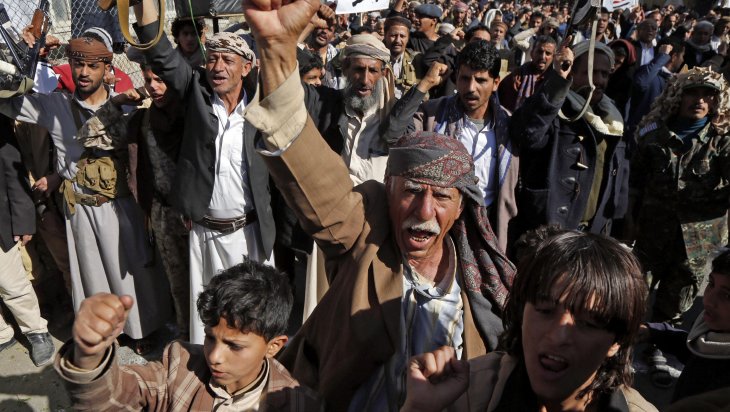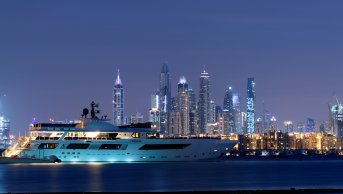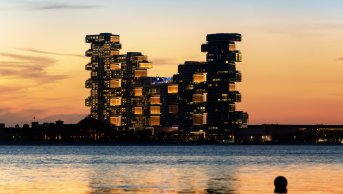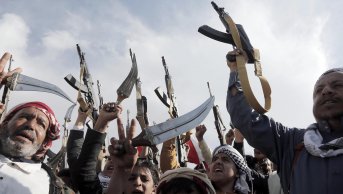One War, Many Battles: The Struggle over Yemen's Marib

The war in Yemen has been escalating in the first three months of 2021. The Houthi movement is strengthening its asymmetric warfare capabilities on many fronts. Using ballistic missiles and unmanned combat aerial vehicles (UCAVs), Houthis are wading into Saudi Arabia and the strongholds of the legitimate Yemeni government.
Efforts to divide Yemen originated in the southern province in the direction of the United Arab Emirates (UAE). Slogans calling for a "South Yemen" are pronounced and continue to drive a deeper wedge between the Abdrabbuh Mansur Hadi government and the Southern Transitional Council (STC), while the struggle between the northern governorates remains as tumultuous as ever, having recently escalated.
There seem to be two main reasons why the struggle between the Houthis and anti-Houthi forces in the northern provinces is building with such torrential force. The first of the reasons may be classified as local-national and the latter regional-international.
At a local level, the escalation is caused by increased Houthi military operations, intimidation strategies and other war-mongering efforts targeting the Marib province, particularly since the beginning of February 2021.
The second regional reason is the successive Houthi attacks against Saudi territories, oil facilities and residential areas as well as the gradual consolidation of strategic relations between the Houthis and the Iranian regime.
Within this context, the battle for Marib strongly pertains to the Houthis’ military and political strategy in Yemen. But on the other hand, the incursions into Saudi soil and the increasingly intertwined alignment between the Houthis and the Iranian regime are shaped by regional and international political conjuncture as well.
The financial and political sanctions imposed on Iran under the Donald Trump administration aimed to substantially weaken the implications and reach of asymmetric strategies of the Iranian regime, as well as its defense, in the wider Middle East.
Also, the recent UAE-Israeli normalization coupled with the fact that Iran’s rivals in the Gulf came to be placed at the center of the anti-Iranian positioning and alignment in the Middle East has likely pushed Iran to rely more on its regional and local armed militias.
The fact that the Houthis had previously appointed an ambassador to Iran in 2019 and that Iran, in turn, appointed an Iranian ambassador to Sanaa, demonstrates the extent of the development of ties between Iran and the Houthis and the strengthened political "unity destiny" between the two.
The city peculiarity
Over the years, the former capital Sanaa and the interim capital Aden have emerged as important centers in the war in Yemen. Before the Houthis captured it, Sanaa was the internationally recognized capital of Yemen. But in 2015, after being captured by the Houthis, the capital Sanaa was replaced by Aden as the latter became the interim capital and home to the legitimate government.
The management of the Yemeni government from Aden was subject to intermittent attacks from the Houthis and the STC from time to time.
After 2016, the Houthis were expelled from Aden and by 2017 the STC had been formed and began to gain political and military ground in Aden with extensive UAE support, making the legitimate government inoperable and vulnerable in the new capital.
Thus, although not all state institutions were officially relocated, the Marib province emerged as one of the most important strongholds of the legitimate government.
With the short-term positioning in Ataq, in the Shabwa region, Marib has become one of the most important points of the war in Yemen, along with Sanaa and Aden.
The prominence of Marib province is due to geo-economic and geopolitical reasons. The city of Marib, from a geo-economic point of view, could be referred to as the center of oil and natural gas resources in Yemen.
The Houthis view the city of Marib as a source of economic income due to its natural resources.
Therefore, the Houthis seek to expand their area of influence in the northern provinces, further east and south, intending to exploit economic resources in the areas they are marching toward.
Marib is also home to a natural gas pipeline that extends to the south to the port of Bilhaf.
In addition to the natural gas pipeline, the oil pipeline passing through Marib continues to the Ras Isa port near Hodeida in the west. Marib, the current center of energy and economy in Yemen, also houses the country’s largest power plant, doubling its economic leverage.
As of 2015, with the seizure of Sanaa by the Houthis, military campaigns aimed at taking over the city of Marib rapidly increased. Besides the geo-economic and geopolitical motivations, Mohammed al-Bukhaiti, one of the leading figures in the Houthis, added a religious element to the military campaigns, claiming that the Houthis taking Marib was a “divine mandate.”
The fact that certain military and official facilities belonging to the legitimate government have been established in Marib doubles the cities importance for the Houthis.
Marib and Gulf relations
After 2015, Marib, which was to a degree isolated from the destructive implications of the war compared to the northern, western and southern provinces in Yemen, became a region to which internally displaced persons (IDPs) flocked.
According to records that predate the war, the population of Marib, which was slightly more than 400,000, climbed to over 3 million in a mere five years.
The fact that Marib hosts 3 million people is also due to the fact that over the last 30 years the city has become the center of energy as a result of the commencement of petroleum production.
At the same time, tribes, which are often overlooked in times of crisis, have established partnerships for common causes that matter for Marib, making the city all the more important.
It is said that the large tribes living in Marib have close relations with Saudi Arabia and the UAE. From the 1980s onward, the UAE leaders carried out socioeconomic projects worth millions of dollars in Marib, including the Marib dam, and established close ties with Marib tribes and leading tribesmen.
Similar to the UAE, Saudi Arabia also allowed Marib tribesmen to work in the kingdom and many students who originated from Marib are studying and working in Saudi Arabia.
However, there are also religious identities in Marib, such as the Shafi'i and Zaidi tribes, which is a testament to the richness of tribes and identities in Yemen.
In this respect, certain tribes and tribesmen, especially those belonging to the Zaidi tribe, are said to feel an ideological and political affiliation – albeit at a low rate – with the Houthis.
What’s next?
The outcome of the war in Yemen could be drastically altered if the Houthis are to seize Marib. But for the legitimate government of Yemen and its supporters, protecting Marib seems to be tantamount to survival.
In this light, Saudi-led coalition officials and the local Marib authorities have been cooperating, and efforts are being made to strengthen Marib’s local capacity to ward off the Houthis.
The Houthis were able to exploit the regions' they captured military weaknesses due to the legitimate government and Saudi-led coalition's inability to strengthen local capacities.
Therefore, a strategic mistake or unwillingness to strengthen a region's ability to defend itself could cost the Saudi-led coalition and the Yemeni government one of its strongholds.
Political motivations, as well as military and geopolitical concerns and implications, can shape Marib’s future.
The Biden administration’s Iran policy – within the inter-institutional disputes in the U.S. – could influence the advancement of the Houthis in Yemen.
The Biden administration no longer recognizes the Houthis as a foreign terrorist organization (FTO), which was most likely considered as an opportunity by the Houthis, despite the U.S. repeatedly warning the Houthis not to increase tension and organize attacks after coming to the decision.
In this sense, Iran may plan to make its presence known in Yemen through Houthis’ attacks on Saudi territories with ballistic missiles and UCAVs and their conventional advance towards Marib.
The Houthis may also seek to take advantage of the “decision moment” in Yemen under the Biden administration and gain military leverage until comprehensive political negotiations are held. But how much this self-disclosure will be tolerated by the Biden administration may have the capacity to shape Iran’s partnership with the Houthis, the future of Marib and the fate of the war in Yemen.
This article was published in Daily Sabah website under the title of “One war, many battles: The struggle over Yemen's Marib” on March 19, 2021.








